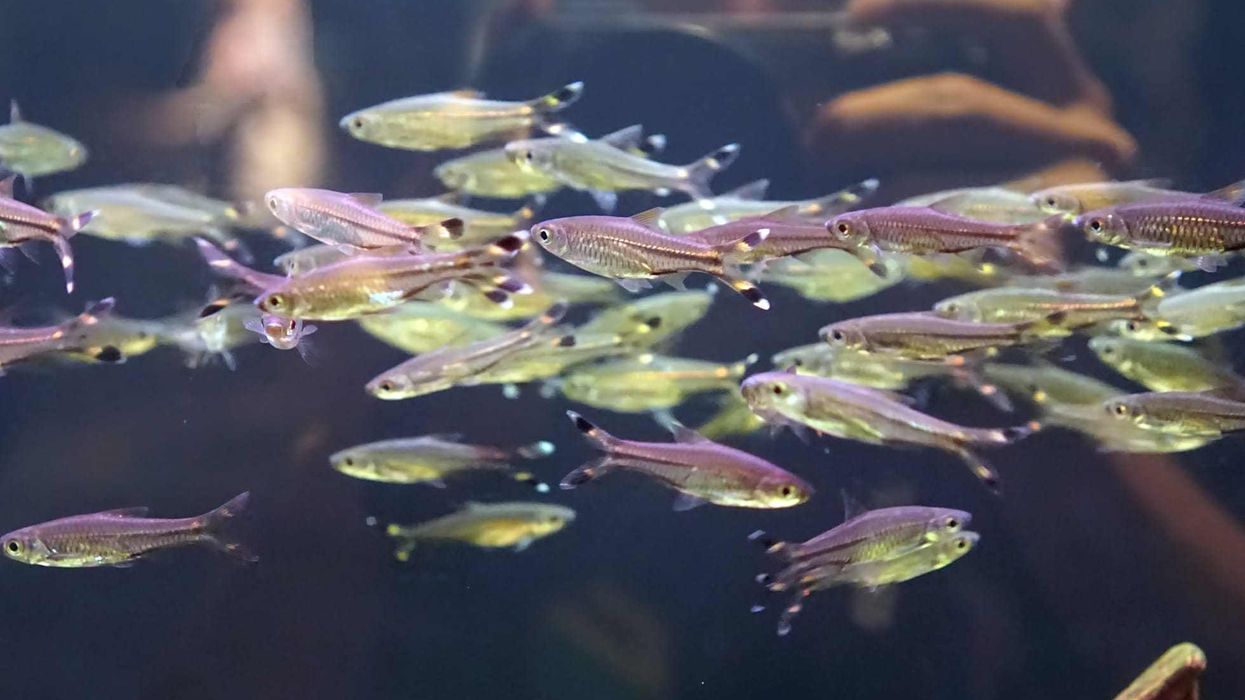The scissortail rasbora is popularly known as the three-lined rasbora and its scientific name is Rasbora trilineata. The scissortail rasbora has a forked tail or caudal fin with black and white markings on it, similar to the dorsal fin of the pristella tetra.
In addition, a horizontal black bar on the midsection runs the length of the body. The forked tail gives them a unique swimming style.
Their tail makes an opening and closing scissor-like motion while they are swimming. They grow up to the size of 6 in (15.2 cm).
If you liked reading this, then you must also give a read to silvery minnow facts and Florida pompano facts.
Scissortail Rasbora Interesting Facts
What type of animal is a scissortail rasbora?
The scissortail rasbora's scientific name is rasbora trilineata. This fish is peaceful in nature and inhabits the Asian tropical freshwater regions.
When put in an aquarium, six of them can be kept together along with other fish species of Cyprinidae. They are very easy to take care of as a pet as these fish species normally have a diet of dried or frozen foods and sometimes like feeding on bloodworms or Daphnia or Artemia.
What class of animal does a scissortail rasbora belong to?
Scissortail rasbora fishes belong to the class Actinopterygii and are mostly kept in an aquarium. They are freshwater fish and are surface dwellers.
How many scissortail rasboras are there in the world?
The exact number of scissortail rasboras is not known, but as their conservation status is of Least Concern and they are found in quite significant numbers there is no threat to their survival. There are also other types of scissortail rasboras like the Red scissortail rasbora or the dwarf scissortail rasbora.
Where does a scissortail rasbora live?
The scissortail rasbora is native to the tropical regions of Chao Phraya and the lower Mekong region river basins in Laos, Thailand, and Cambodia and also in the widespread peninsular in Malaysia. Their distribution extends to the greater Sunda Islands of Sumatra and Borneo.
It is hard to spot one in the wild as they are bred in great numbers commercially.
What is a scissortail rasbora's habitat?
The scissortail rasbora is of Asian origin. They are adaptable and has various habitat including the freshwater of swiftly-flowing forest hill streams with boulders, small stones, sand or gravel bed and also more sluggish blackwater areas.
It is also known to inhabit reservoirs and lakes and moves to the flooded areas during the wet season.
If they are to be put in the aquarium, they should have a normal temperature of 73-77 F (22.7-25 C), and the pH level should be between 5.o-8.0 depending on its origin, and the aquarium should have a capacity of about 56 gal (255 l).
The aquarium should also be decorated with plants, leaves, and branches to make it a suitable environment for them.
Who do scissortail rasboras live with?
The rasbora trilineata is a gregarious species by nature and remains in groups. When kept in aquariums, they should be kept in a group of at least six as they show better colors in the presence of others.
These species are peaceful, making them ideal for larger community fish tanks. They can be paired easily with other species of cyprinids like the tetras, red rainbowfish, anabantoids, livebearers, catfish, and loaches.
How long does a scissortail rasbora live?
The scissortail rasbora has a lifespan of five years and sometimes longer. They like swimming on the surface and thus often fall prey to birds and other predators.
How do they reproduce?
The rasbora scissortail is like most other egg-scattering cyprinids who exhibit no parental signs. And just like other fishes, the females appear full of eggs, and when they scatter their eggs, the males fertilize them outside.
However, the adults might eat any eggs they find, so it is best to remove them after a few days. It takes 18-48 hours for the rasbora fry to come swimming up.
What is their conservation status?
Their conservation status is of Least Concern as they are found adequately in South Asia.
Scissortail Rasbora Fun Facts
What do scissortail rasboras look like?

*Please note that this is an image of a Harlequin rasbora, not a Scissortail Rasbora specifically. If you have an image of a Scissortail Rasbora, then please let us know at hello@kidadl.com.
The scissortail rasbora is a sleek freshwater fish that energizes community life in a larger aquarium. They are known for their forked tail that resembles an open pair of scissors. Their tail moves like a scissor opening and closing while they are swimming. They are silver in color with black and white markings on their caudal fin.
How cute are they?
They are pretty cute and are a real gem to the fish tank. Their tails are really unique, and it's a real pleasure to watch them while swimming as their tail opens and closes like scissors.
How do they communicate?
It is known that the scissortail rasbora communicates just like other fishes, using gestures and motions.
How big is a scissortail rasbora?
The scissortail rasbora can grow up to 6 in (15.2 cm) in length, and they are well-adjusted to big aquariums with suitable temperature and water conditions.
How fast can a scissortail rasbora swim?
Scissor tails can swim pretty fast as fish and also tend to have jumping abilities. They prefer to stay in large aquariums with lots of aquatic plants, leaves, and branches, making a perfect environment for them to stay.
How much does a scissortail rasbora weigh?
Not much is know about their weight, but according to their length, they may weigh somewhere around 1.28 oz (36.2 g).
What are the male and female names of the species?
There are no sex-specific names for scissortail rasboras.
What would you call a baby scissortail rasbora?
A baby rasbora is called fry.
What do they eat?
The wild species like feeding on invertebrates like worms, both aquatic and terrestrial, and particularly insects. Whereas in the aquarium, it has dried foods as its diet but should not be fed too much.
Daphnia and artemia are small live and frozen foods that are a good diet and will result in a good coloration in the rasboras and encourage them to come to the breeding conditions.
Feeding them is not a problem as they will take any dried and frozen foods. A good quality fish food should serve as the main part of their
Are they eaten by humans?
No, rasbora scissor-tailed fish are not eaten by humans as they are commercial fish meant for the aquarium.
Would they make a good pet?
Yes, they will make a good pet as they are mostly caught for the aquarium. However, these species might have a bad temperament if they are introduced to the aquarium too quickly. So it would be best if you acclimatize them to the water conditions before you put them in the aquarium.
Did you know...
The difference between the male and the females is not distinct, though males are more slender than females. The males are more intensely colored during the breeding season, whereas the females are larger and round.
The scissortail rasbora's breeding process
They breed just like other fishes, but a separate breeding tank is recommended when in an aquarium. When the females are full of eggs, place the pairs in the breeding tank, and to induce spawning, add few measures of cold water throughout the day.
Once their eggs are laid and fertilized, the adults should be removed from the tank, or they will eat the eggs.
Keeping scissortail rasboras
It is suggested to keep the scissortail rasboras in a well-planted aquarium with decorative river pebbles of large size. The tank can be further furnished accordingly with few driftwood branches and aquatic plants for aesthetic value.
It will also stay well in a tank set up as a pet swamp with dim lights, roots, branches, leaf litter, and aquatic plants. If they are kept in groups, they will need a fish tank with a minimum tank size of 30 gal (136.3 l).
The tank should have a tightly fitted cover as these species are surface dwellers and are likely to jump through even the tiniest gaps.
Like all other fish species, they need a clean environment, and the tank needs to be cleaned at regular intervals. It is suggested to ask about the origin of the fish before purchasing so that you can understand their needs.
Here at Kidadl, we have carefully created lots of interesting family-friendly animal facts for everyone to discover! For more relatable content, check out these giant guitarfish facts and giant frogfish facts for kids.
You can even occupy yourself at home by coloring in one of our free printable scissortail rasbora coloring pages.










